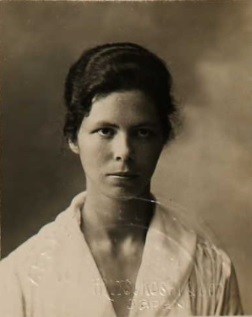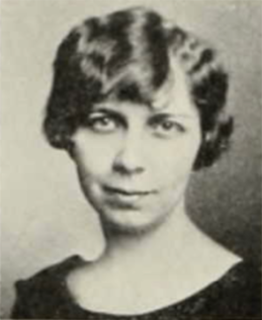Related Research Articles

Lenore "Lee" Krasner was an American abstract expressionist painter, with a strong speciality in collage, who was married to Jackson Pollock. Although there was much cross-pollination between their two styles, the relationship somewhat overshadowed her contribution for some time. Krasner’s training, influenced by George Bridgman and Hans Hofmann, was the more formalized, especially in the depiction of human anatomy, and this enriched Pollock’s more intuitive and unstructured output.

Elaine Marie Catherine de Kooning was an Abstract Expressionist and Figurative Expressionist painter in the post-World War II era. She wrote extensively on the art of the period and was an editorial associate for Art News magazine.
Chizuko Yoshida was a Japanese modernist artist, whose work reflected the development of art in Japan following World War II. She was noted for providing a connective link between widespread modern art movements and traditional Japanese imagery.
Dorothea Rockburne is an abstract painter, drawing inspiration primarily from her deep interest in mathematics and astronomy. Her work is geometric and abstract, seemingly simple but very precise to reflect the mathematical concepts she strives to concretize. "I wanted very much to see the equations I was studying, so I started making them in my studio," she has said. "I was visually solving equations." Rockburne's attraction to Mannerism has also influenced her work.

Barbara Morgan was an American photographer best known for her depictions of modern dancers. She was a co-founder of the photography magazine Aperture.

Miriam Schapiro was a Canadian-born artist based in the United States. She was a painter, sculptor, printmaker, and a pioneer of feminist art. She was also considered a leader of the Pattern and Decoration art movement. Schapiro's artwork blurs the line between fine art and craft. She incorporated craft elements into her paintings due to their association with women and femininity. Schapiro's work touches on the issue of feminism and art: especially in the aspect of feminism in relation to abstract art. Schapiro honed in her domesticated craft work and was able to create work that stood amongst the rest of the high art. These works represent Schapiro's identity as an artist working in the center of contemporary abstraction and simultaneously as a feminist being challenged to represent women's "consciousness" through imagery. She often used icons that are associated with women, such as hearts, floral decorations, geometric patterns, and the color pink. In the 1970s she made the hand fan, a typically small woman's object, heroic by painting it six feet by twelve feet. "The fan-shaped canvas, a powerful icon, gave Schapiro the opportunity to experiment … Out of this emerged a surface of textured coloristic complexity and opulence that formed the basis of her new personal style. The kimono, fans, houses, and hearts were the form into which she repeatedly poured her feelings and desires, her anxieties, and hopes".

April Gornik is an American artist who paints American landscapes. Her realist yet dreamlike paintings and drawings embody oppositions and speak to America's historically conflicted relationship with nature. While she doesn't categorize herself as an environmental artist, she is a passionate supporter of environmental causes and has said, "I have no problem with people reading an ecological message into my work."

The Parrish Art Museum is an art museum designed by Herzog & de Meuron Architects and located in Water Mill, New York, whereto it moved in 2012 from Southampton Village. The museum focuses extensively on work by artists from the artist colony of the South Shore and North Shore.

Perle Fine (1905–1988) was an American Abstract expressionist painter. Fine was most known by her combination of fluid and brushy rendering of the materials and her use of biomorphic forms encased and intertwined with irregular geometric shapes.

Lilian May Miller was an American painter, woodblock printmaker and poet born in Tokyo, Japan. In the world of art she marked her place with imagery, while she attended presentations in traditional kimonos, and signed her paintings with a monogram.
Bruce Wolosoff is an American classical composer, pianist, and educator. He lives in Shelter Island, New York with his wife, the artist Margaret Garrett. He has two daughters, the singer-songwriter Juliet Garrett and the sculptor and mixed media artist Katya Wolosoff.

Blanche Lazzell was an American painter, printmaker and designer. Known especially for her white-line woodcuts, she was an early modernist American artist, bringing elements of Cubism and abstraction into her art.
Margaret Nairne Mellis was a British artist, one of the early members and last survivors of the group of modernist artists that gathered in St Ives, in Cornwall, in the 1940s. She and her first husband, Adrian Stokes, played an important role in the rise of St Ives as a magnet for artists. She later married Francis Davison, also an artist, and became a mentor to the young Damien Hirst.

Joan Semmel is an American feminist painter, professor, and writer. She is best known for her large scale realistic nude self portraits as seen from her perspective looking down.

Gabrielle de Veaux Clements was an American painter, print maker, and muralist. She studied art at the Philadelphia School of Design for Women, Pennsylvania Academy of the Fine Arts, and in Paris at Académie Julian. Clements also studied science at Cornell University and graduated with a Bachelor of Science degree. She created murals, painted portraits, and made etchings. Clements taught in Philadelphia and in Baltimore at Bryn Mawr School. Her works have been exhibited in the United States and at the Paris Salon. Clements works are in several public collections. Her life companion was fellow artist Ellen Day Hale.
Eunice Golden is an American feminist painter from New York City, known for exploring sexuality using the male nude. Her work has been shown at the Whitney Museum of American Art, Brooklyn Museum, Bronx Museum of the Arts, Westbeth Gallery, and SOHO20 Gallery, among others.
Holly Meade was an American artist best known for her woodblock prints and for her illustrations for children's picture books.

Ethel Mars was an American woodblock print artist, known for her white-line woodcut prints, also known as Provincetown Prints, and a children's book illustrator. She had a lifelong relationship with fellow artist Maud Hunt Squire, with whom she lived in Paris and Provincetown, Massachusetts.

Mabel Hewit (1903–1984) was an American woodblock print artist, particularly the white-line style of the Provincetown Printers.
Charlotte Park (1918–2010) was an American abstract painter. She began work as a professional artist soon after the close of World War II, working in studios first in Manhattan and then in eastern Long Island. She was associated with and drew both support and inspiration from her husband James Brooks and other first-generation abstract expressionist artists, including particularly her neighbors, Jackson Pollock, and Lee Krasner. During most of her career she neither sought nor received praise from critics and collectors, but late in life was celebrated for the quality of her artistic achievements and had her work shown in prestigious solo and group exhibitions. At the end of her life a critic said, "Hers was a major gift all but stifled by a happily embraced domesticity and by the critical bullying of a brutally doctrinaire art world."
References
- 1 2 3 Moss, Drew (27 January 2014). "The Art of the Dance: The Tuning Fields of Margaret Garrett" (PDF). Long Island Pulse. Retrieved 13 August 2020.
- ↑ Garrett, Margaret (29 January 2020). "The Artist's View: Margaret Garrett". vimeo.com. Retrieved 13 August 2020.
- ↑ Myers, Coco (2020). Hamptons Artists: The Current Wave. folioeast. ISBN 9781715577834.
- 1 2 van Straaten, Laura (27 January 2014). "Margaret Garrett, Emil Lukas, and Melissa Meyer". Whitewall. Retrieved 13 August 2020.
- 1 2 Gotthardt, Alexxa (1 January 2015). "A Former Dancer's Gestural Paintings Bring the Motion of Dance to Canvas". artsy.com. Retrieved 13 August 2020.
- 1 2 Rogers, Pat (11 April 2018). "Artists Unfurled: Shelter Island Artist Exhibits in Dallas Following a Virginia Residency". Hamptons Art Hub. Retrieved 13 August 2020.
- ↑ Gladstone, Valerie (April 2014). "Reviews: Margaret Garrett, Birnam Wood Galleries". ARTnews. 113: 102.
- 1 2 Dempsey, Susan Carey (30 July 2020). "Celebrating the Vote: Artist Interprets History". Shelter Island Reporter.
- 1 2 "Garrett's Artwork Is Inspired By Martha Graham And The 19th Amendment". 27 East. 2020-09-07. Retrieved 2020-09-11.
- ↑ Sherwood, M. "19 Poses". Martha Graham Dance Company. Retrieved 2020-08-14.
- ↑ Garrett, Margaret (2020-06-24), 19 Poses- Making the Woodblock Triptychs , retrieved 2020-08-14
- ↑ "Editors' Picks: 16 Events for Your Art Calendar This Week, From a Virtual Print Fair to an IRL Show Inspired by the 19th Amendment". artnet News. 2020-10-06. Retrieved 2020-11-02.